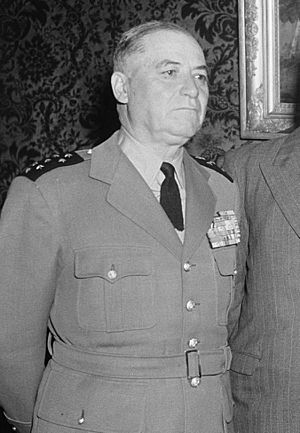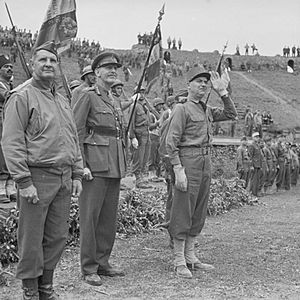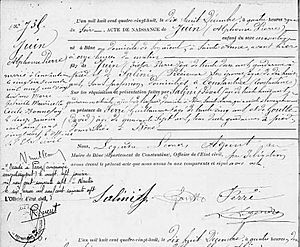Alphonse Juin facts for kids
Quick facts for kids
Marshal
Alphonse Juin
|
|
|---|---|

Marshal Juin in 1952
|
|
| Seat 4 of the Académie française | |
| In office 20 November 1952 – 27 January 1967 |
|
| Preceded by | Jean Tharaud |
| Succeeded by | Pierre Emmanuel |
| Resident-General of France in Morocco | |
| In office 15 May 1947 – 28 August 1951 |
|
| Preceded by | Eirik Labonne |
| Succeeded by | Augustin Guillaume |
| Chief of the Defence Staff | |
| In office 25 January 1951 – 19 August 1953 |
|
| Preceded by | Charles Léchères |
| Succeeded by | Paul Ély |
| In office 13 August 1944 – 15 May 1947 |
|
| Preceded by | Antoine Béthouart |
| Succeeded by | Charles Léchères |
| Personal details | |
| Born | 16 December 1888 Bône, French Algeria |
| Died | 27 January 1967 (aged 78) Paris, French Republic |
| Resting place | Les Invalides |
| Nationality | French |
| Spouse |
Marie Gabrielle Mauricette Cécile Bonnefoy
(m. 1928) |
| Children | Pierre Juin |
| Parents |
|
| Alma mater |
|
| Military service | |
| Allegiance | |
| Branch/service | French Army |
| Years of service | 1912 – 1962 |
| Rank | Army general |
| Unit |
List of units
1st Zouaves Regiment
1st Algerian Tirailleurs Regiment 9th Algerian Tirailleurs Regiment 19th Algerian Tirailleurs Regiment 3rd Zouaves Regiment |
| Commands |
List of commands
|
| Battles/wars | Zaian War
List of battles
Rif War List of battles
|
Alphonse Pierre Juin (16 December 1888 – 27 January 1967) was an important French Army general. He later became a Marshal of France, which is the highest military rank in France.
Juin graduated from a famous military school called the École Spéciale Militaire de Saint-Cyr in 1912. He served in Morocco with local troops. When World War I started, he was sent to fight in France. He was badly wounded in 1915 and lost the use of his right arm.
After the war, he continued his military training. He chose to serve in North Africa again. When World War II began in 1939, he led the 15th Motorized Infantry Division. His division was surrounded during the Battle of France, and Juin was captured. He was a prisoner of war until 1941. He was then released and put in charge of French forces in North Africa.
After the Allies (British and American forces) invaded North Africa in November 1942, Juin ordered French troops in Tunisia to fight against the Germans and Italians. He showed great skill during the Italian campaign. He commanded the French Expeditionary Corps. His knowledge of mountain warfare was key to breaking the Winter Line, a strong German defense that had stopped the Allies for six months.
Later, he became the Chief of Staff for the French forces. In 1947, he returned to Africa as the French leader in Morocco. He was promoted to Marshal of France in 1952 while serving in a senior NATO position. He strongly disagreed with Charles De Gaulle's decision to give independence to Algeria. Because of this, he was "retired" in 1962. He was the last living Marshal of France from the French Army until he died in Paris in 1967. He was buried in Les Invalides, a famous military burial place.
Contents
Early Life and Military Training
Alphonse Juin was born in Bône (now Annaba) in French Algeria on December 16, 1888. He was the only son of Victor Pierre Juin, a soldier who became a police officer. His mother, Précieuse Salini, was also from a military family.
When he was six, his family moved to Constantine. There, he went to primary school and learned Arabic from local boys. In 1902, he received a scholarship to study at a high school in Constantine.
In 1909, he passed the entrance exam for the École spéciale militaire de Saint-Cyr, a top military academy. Before starting the course, cadets had to spend a year in the Army. So, he joined an Algerian regiment and quickly became a corporal and then a sergeant. He entered Saint-Cyr in 1910. His class was known as promotion de Fès.
Many of his classmates became important generals, including Charles de Gaulle. Juin and de Gaulle remained close friends throughout their lives. After graduating in 1912, Juin became a second lieutenant. He soon served in Morocco during the Zaian War.
Fighting in World War I
When First World War began in August 1914, Juin was sent to the Western Front in France. He joined a brigade of Moroccan troops. On September 5, his unit fought in the First Battle of the Marne. Juin was wounded in his left hand the next day. He refused to leave the front and kept fighting with his arm in a sling. For his bravery, he received the Cross of the Legion of Honour.
In March 1915, during the First Battle of Champagne, Juin was wounded again. This time, his upper right arm was permanently damaged. He was allowed to salute with his left arm from then on.
After recovering in Morocco, Juin returned to France in late 1916. He led a company of Moroccan soldiers and took part in the Nivelle Offensive in April 1917. In 1918, he was chosen for staff training. He later joined the French Mission to the United States Army, where he was serving when the war ended in November 1918.
Between the World Wars
After World War I, Juin returned to North Africa. He continued his military training at the École Supérieure de Guerre. After graduating in 1921, he was sent to Tunisia. He chose to serve in Morocco under General Joseph-François Poeymirau, who sadly died in 1924.
Juin then worked in logistics, making sure forts in the Ouergha River area had supplies. During the Rif War, he served on the staff of Colonel Charles Noguès. For his leadership in battle, Juin was made an officer of the Legion of Honour and promoted to battalion chief.
In 1927, Juin returned to North Africa to command a battalion. In 1928, he married Marie Gabrielle Cécile Bonnefoy. They had two sons, Pierre and Michel. He continued to rise through the ranks, becoming a lieutenant-colonel in 1932 and a colonel in 1935.
In 1937, Noguès became the French leader in Morocco. He wanted Juin to be his chief of staff if war broke out with Nazi Germany. Juin attended a senior officers' course and was promoted to brigadier general on December 26, 1938.
World War II Service
The Fall of France
When Second World War started in September 1939, Juin helped send troops from North Africa to defend France. On December 4, he was given command of the 15th Motorized Infantry Division. After the German attack began on May 10, 1940, Juin's division was ordered to Belgium. They fought bravely against German attacks on May 14 and 15.
His division later retreated into the Lille pocket. They covered British and French forces fighting in the Battle of Dunkirk. Some of his units managed to escape to Dunkirk. The rest fought until they ran out of ammunition. Juin surrendered on May 29 and became a prisoner of war.
He was held in a prison camp in Germany. While there, he was promoted to division general. He was released in June 1941 at the request of the Vichy Government. He was seen as an expert in North African affairs. He was promoted again and became commander of French land forces in North Africa.
North African Campaign

Operation Torch, the Allied invasion of Algeria and Morocco in November 1942, surprised Juin. He had orders to resist any invasion. However, he quickly understood the situation. He negotiated a ceasefire in Algiers with American forces. French resistance continued elsewhere until a general ceasefire was issued. Juin then ordered French forces in Tunisia to fight the Germans and Italians.
His forces were not well-equipped. When the Germans and Italians counter-attacked, he had to ask for British and American help. In January 1943, French forces were grouped into the XIX Corps, which was placed under the British First Army.
Juin was promoted to army general. He received a huge welcome when he entered Tunis after the Allies captured the city in May. He joined other top Allied leaders for a victory parade on May 20.
Italian Campaign
In July 1943, Juin agreed that French troops could join the Italian campaign. He was put in charge of the Corps Expéditionnaire Français (CEF). This force would work with the U.S. Fifth Army.
The CEF played a key role in the Battle of Monte Cassino. In January 1944, they advanced four miles to the main defenses of the German Winter Line. They fought hard and suffered many losses but achieved their goals.
After three failed attempts to break the Gustav Line, Allied commanders planned a new attack called Operation Diadem. Juin suggested a major change to the plan. He proposed that the CEF, now with four divisions, advance through the tough Aurunci Mountains. He believed his 4th Moroccan Mountain Division and Moroccan Goumiers could outflank the German positions. This bold plan worked. Juin's forces broke through the German lines, helping the Allies advance.
Juin entered Rome triumphantly with American General Mark W. Clark. On July 4, the CEF captured Siena. They then withdrew to take part in Operation Dragoon, the Allied invasion of Southern France.
Chief of Staff
After the Italian campaign, Juin became the chief of staff of French forces. He helped convince General Eisenhower to allow Philippe Leclerc's 2nd Armoured Division to liberate Paris. Juin entered the city with de Gaulle on August 25, 1944. He worked to restore order in the liberated areas.
During the German Operation Northwind in January 1945, Juin disagreed with a proposed Allied withdrawal from Alsace and Lorraine. However, the withdrawal was not carried out.
Later Life and Retirement
At the end of World War II in Europe, Juin was in the United States. He represented France at the San Francisco Conference. After the war, he continued to help rebuild France's armed forces. This was difficult due to limited resources and many military duties.
In May 1947, Juin returned to Africa as the French leader in Morocco. He worked to manage France's relationship with Morocco. He tried to expand opportunities for Moroccans.
Juin visited Indochina in 1946 and 1950. He reported on the difficult situation there. However, he turned down offers to command French forces in Indochina, as he was more concerned about North Africa.
On November 20, 1952, Juin was elected to the Académie Française, a prestigious French institution.
In 1953, Juin took on a senior NATO position, commanding CENTAG. He worked well with American generals like Eisenhower. In May 1952, during his NATO command, he was promoted to Marshal of France. He was the only living person to hold this rank at the time.
After the French defeat in Indochina in 1954, Juin was again asked to take command there. He was deeply affected by the disaster but again declined the job. He retired on October 1, 1956.
Juin strongly disagreed with de Gaulle's decision to grant independence to Algeria. Despite this, he remained loyal to de Gaulle. In 1961, he was placed under house arrest due to political tensions. He was "retired" and lost some of his special privileges as a marshal.
In December 1963, he became ill and was hospitalized. De Gaulle visited him. Juin spoke of Algeria as his country, and de Gaulle comforted him. Juin remained frail after this illness. He suffered a heart attack in November 1966 and died on January 22, 1967. His funeral was held at Notre Dame de Paris, attended by many important figures, including de Gaulle. Juin was buried with full military honors in Les Invalides.
Military Ranks
Images for kids
See also
 In Spanish: Alphonse Juin para niños
In Spanish: Alphonse Juin para niños





